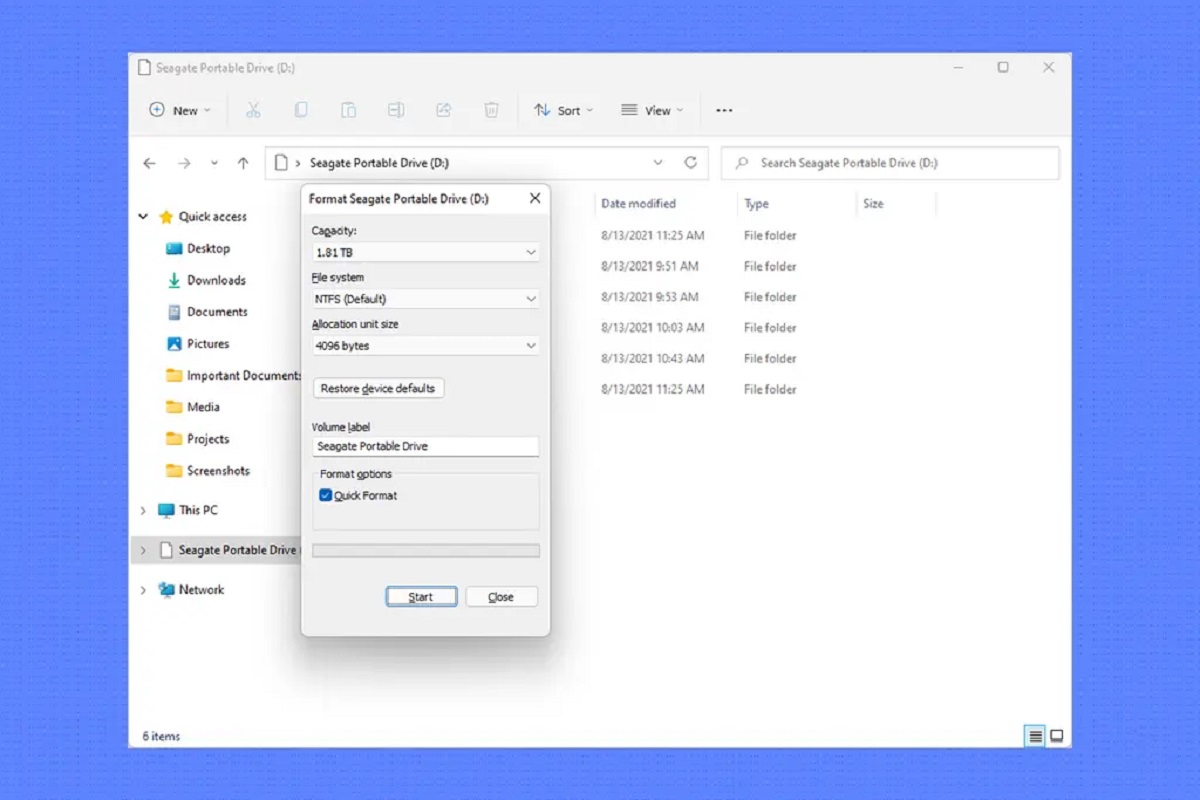Introduction
Welcome to this guide on how to reformat a Solid State Drive (SSD) in Windows 10. If you’re experiencing issues with your SSD or simply want a fresh start, reformatting the drive can help. This process involves deleting any existing data on the drive and setting it up with a new file system that is compatible with Windows 10.
SSDs are becoming increasingly popular due to their fast performance and reliability. They use flash memory to store data, making them more durable than traditional hard drives. However, just like any storage device, SSDs may need to be reformatted for various reasons, such as when you want to clean up the drive, troubleshoot problems, or prepare the drive for a new operating system installation.
Reformatting an SSD involves erasing all the data on the drive, so it’s crucial to have a backup of your important files before proceeding. This ensures that you won’t lose any valuable data during the reformatting process. Once you have a backup, you can confidently proceed with reformatting your SSD.
In this guide, we’ll walk you through the step-by-step process of reformatting an SSD in Windows 10. We’ll cover everything from checking the drive’s health to deleting existing partitions and creating new ones. By the end of this guide, you’ll have a fully reformatted SSD ready for use.
Before we begin, it’s important to note that reformatting an SSD will permanently erase all data on the drive. Make sure you have a backup and double-check that you’re reformatting the correct drive to avoid any unintentional data loss.
Overview of Solid State Drives
Before diving into the process of reformatting a Solid State Drive (SSD), let’s take a moment to understand what an SSD is and why it’s important to know about its characteristics.
An SSD is a type of storage device that uses flash memory to store data electronically. Unlike traditional hard drives that use spinning disks and mechanical components to access data, SSDs have no moving parts. This makes them faster, more reliable, and less prone to physical damage.
One of the key advantages of SSDs is their speed. They offer significantly faster read and write speeds compared to traditional hard drives, which means that data can be accessed and transferred much more quickly. This speed is particularly beneficial for tasks that involve heavy data processing, such as gaming, video editing, and running multiple applications simultaneously.
In addition to speed, SSDs are known for their durability. Since they don’t have any mechanical parts, they are less susceptible to physical shock and vibration. This makes them ideal for use in laptops and portable devices that may experience frequent movement.
Another notable characteristic of SSDs is their silent operation. Unlike hard drives that produce noise due to the spinning of disks, SSDs operate silently. This can be particularly advantageous for those who appreciate a quiet computing environment.
Furthermore, SSDs are more energy-efficient compared to traditional hard drives. They consume less power, which can extend the battery life of laptops and reduce overall energy consumption.
It’s important to note that while SSDs offer many advantages over traditional hard drives, they also have some limitations. The most common limitation is their relatively higher cost per gigabyte of storage compared to hard drives. However, as technology advances and demand increases, SSD prices continue to decrease, making them more accessible to a wider range of users.
Now that we have an understanding of the features and benefits of SSDs, let’s move on to the process of reformatting an SSD in Windows 10.
Understanding Formatting
Before you begin the process of reformatting your Solid State Drive (SSD) in Windows 10, it’s important to have a clear understanding of what formatting actually means.
In the context of computer storage, formatting refers to the process of preparing a storage device to be used by an operating system, such as Windows 10. This process involves creating a file system, which is a structured way of organizing and allocating space on the drive to store data.
When you format an SSD, you essentially erase all the existing data on the drive and set it up with a fresh file system. This is different from simply deleting files, as formatting wipes out all the data on the drive and prepares it for a clean start.
There are several reasons why you might want to format an SSD. One common reason is to clean up the drive and remove any unnecessary or corrupted files. Formatting can help improve the overall performance and efficiency of the SSD by removing fragmented data and resetting the file system.
Formatting also allows you to prepare the SSD for a new operating system installation. If you’re planning to reinstall Windows 10 or change to a different operating system, formatting the SSD is necessary to ensure a clean installation without any conflicts or remnants of the previous system.
It’s important to note that formatting an SSD will permanently erase all the data on the drive. Therefore, it’s crucial to have a backup of your important files before proceeding. Make sure to save copies of your documents, photos, videos, and any other valuable data on an external storage device or cloud storage service.
Formatting an SSD can be done through various methods, such as using the built-in Disk Management tool in Windows 10 or using third-party software. In this guide, we’ll focus on using Disk Management, as it is a reliable and accessible option for most Windows 10 users.
Now that you have a clear understanding of what formatting entails, let’s move on to the steps involved in reformatting an SSD in Windows 10.
Backup Your Data
Before you proceed with reformatting your Solid State Drive (SSD) in Windows 10, it’s crucial to create a backup of your important data. Reformatting will erase all the existing data on the drive, so having a backup ensures that you won’t lose any valuable files during the process.
Creating a backup of your data is a straightforward process that can be done using various methods. Here are a few options:
- External Hard Drive or USB Drive: Connect an external hard drive or a USB drive to your computer and manually copy and paste your important files to the external storage device. This method is simple and allows you to have a physical copy of your data.
- Cloud Storage Services: Use cloud-based storage services like Google Drive, Dropbox, or OneDrive to back up your files. These services provide secure online storage and allow you to access your files from any device with an internet connection.
- System Backup Software: Utilize backup software or built-in system backup tools to create a complete system backup, including all your files, settings, and applications. This option provides a comprehensive backup solution, but it may require additional configuration and time to restore the backup later.
Decide which backup method suits your needs and preferences. It’s recommended to choose a method that ensures your data is stored in a reliable and secure location.
Make sure to include all important files such as documents, photos, videos, music, and any other personal data that you don’t want to lose. It’s also wise to double-check the backup to ensure that all the files have been successfully copied.
Remember, reformatting an SSD will erase all the data on the drive, so it’s better to be cautious and thorough with your backup process. It’s always better to be safe than sorry when it comes to safeguarding your valuable data.
Once you have successfully backed up your data and double-checked the backup, you’re ready to proceed with the reformatting process. In the following sections, we’ll guide you through the steps to reformat your SSD in Windows 10.
Check Drive Health and Remove Encryption
Before you begin the process of reformatting your Solid State Drive (SSD) in Windows 10, it’s important to check the drive’s health and remove any encryption that might be in place. This ensures that the drive is functioning properly and allows for a smooth reformatting process.
Here are two important steps to perform before proceeding with the reformatting:
1. Check Drive Health: It’s essential to ensure that your SSD is in good health before going ahead with the reformatting process. A failing or problematic SSD can cause issues during or after the reformatting process. To check the health of your drive, you can use built-in tools or third-party software specifically designed for this purpose.
In Windows 10, you can use the built-in “Error Checking” tool to scan your SSD for any errors or issues. To access this tool, follow these steps:
- Open “File Explorer” by pressing the Windows key + E on your keyboard.
- Locate your SSD in the list of drives and right-click on it.
- Select “Properties” from the context menu.
- In the Properties window, navigate to the “Tools” tab.
- Click on the “Check” button under the “Error Checking” section.
- Follow the on-screen instructions to scan and repair any errors on the drive.
Once the scanning and repair process is complete, you can proceed with reformatting your SSD.
2. Remove Encryption: If your SSD is encrypted, it’s advisable to remove the encryption before reformatting. Encryption scrambles the data stored on your drive, making it inaccessible without the correct encryption keys. Reformatting the SSD while it is encrypted may cause data loss or other complications.
If you have BitLocker encryption enabled on your SSD, you will need to decrypt the drive before proceeding with the reformatting. Here’s how you can do it:
- Open “Control Panel” by searching for it in the Windows Start menu.
- Click on “System and Security,” then select “BitLocker Drive Encryption.”
- Under the “BitLocker Drive Encryption” section, locate your SSD and click on “Turn off BitLocker.”
- Follow the on-screen instructions to decrypt the drive.
Once the drive has been decrypted and you have ensured its health, you can move on to the next steps of reformatting your SSD.
By checking the drive health and removing any encryption, you are taking proactive measures to ensure a smooth reformatting process and reduce the risk of potential complications or data loss.
Open Disk Management
Once you have checked the health of your Solid State Drive (SSD) and removed any encryption, it’s time to open Disk Management, a built-in Windows 10 tool that allows you to manage and configure storage devices, including formatting your SSD.
To open Disk Management, follow these steps:
- Press the Windows key + X on your keyboard simultaneously to open the Power User Menu.
- In the Power User Menu, select “Disk Management” from the list of options. This will open the Disk Management window.
Alternatively, you can open Disk Management by using the Run dialog box:
- Press the Windows key + R on your keyboard to open the Run dialog box.
- Type “diskmgmt.msc” into the Run dialog box and press Enter.
Once you have opened Disk Management, you will see a graphical representation of all the storage devices connected to your computer. The SSD should be listed as one of the drives in the lower section of the window.
Take a moment to familiarize yourself with the Disk Management interface. Here, you can view information about your SSD, such as the drive letter, the size of the drive, and the file system currently in use. You can also perform various actions on the drive, including initializing, formatting, and deleting partitions.
Now that you have successfully opened Disk Management, you’re ready to proceed with the next steps in reformatting your SSD.
Note: It’s important to be cautious when using Disk Management, as it provides access to critical storage management functions. Make sure to double-check the drive you are working with to avoid accidentally formatting the wrong drive and causing data loss.
Locate the SSD
After opening Disk Management, the next step in reformatting your Solid State Drive (SSD) in Windows 10 is to locate the SSD within the Disk Management window. Once located, you can proceed with the necessary steps to format the SSD.
Here’s how you can locate your SSD within the Disk Management window:
- In the Disk Management window, look for a graphical representation of your drives in the lower section.
- Scan through the list of drives and identify the SSD based on its size and other distinctive features.
- Typically, the SSD will be labeled with the drive letter assigned to it, such as “C:”, “D:”, or any other alphabetical letter.
- Make a note of the drive letter and any other identifying information to ensure that you are working with the correct SSD.
It’s worth mentioning that sometimes the SSD may not be assigned a drive letter, or it may be listed as “Unallocated” or “Not Initialized.” In such cases, you will need to initialize the SSD before you can proceed with formatting it. Initializing the SSD initializes the disk and allows it to be recognized by the operating system.
Once you have located the SSD and made note of its drive letter or status, you can move on to the next steps in the reformatting process.
It’s important to exercise caution when locating the SSD to avoid accidentally formatting the wrong drive. Make sure to verify the drive letter and double-check that you are working with the correct SSD. Formatting the wrong drive can result in permanent data loss, so take your time and be thorough in your verification process.
Now that you have identified the SSD, let’s proceed with the next steps to reformat it in Windows 10.
Delete Existing Partitions
Once you have located your Solid State Drive (SSD) in the Disk Management window, the next step in reformatting the drive is to delete any existing partitions. Partitions are sections of the drive that are separated and designated for specific purposes, such as storing files or installing an operating system.
Here’s how you can delete existing partitions on your SSD:
- Right-click on the SSD partition that you want to delete. It will be listed as a rectangular block on the Disk Management window.
- From the context menu, select “Delete Volume” or “Delete Partition.” This will initiate the process of deleting the selected partition.
- A warning message may appear, informing you that all data on the partition will be destroyed. Make sure you have backed up any important data before proceeding.
- Confirm the deletion by clicking “Yes” or “OK” on the confirmation prompt.
- The partition will be deleted, and the space it occupied will become unallocated, meaning it is now available for formatting and creating new partitions.
- Repeat this process for any additional partitions on your SSD that you want to delete.
It’s important to note that deleting partitions will permanently remove all data stored within them. Ensure that you have backed up any important files before proceeding.
After deleting all the unwanted partitions on your SSD, you should have a clean slate for formatting and setting up the drive with a new file system.
Now that you have successfully deleted existing partitions on your SSD, let’s move on to the next steps to create new partitions and format the drive.
Create New Partitions
After deleting the existing partitions on your Solid State Drive (SSD), the next step in the reformatting process is to create new partitions. Partitions allow you to divide the SSD into separate sections for better organization and utilization of the storage space.
Here’s how you can create new partitions on your SSD:
- Right-click on the unallocated space on your SSD, which represents the space previously occupied by the deleted partitions.
- From the context menu, select “New Simple Volume” or “New Partition.” This will open the New Simple Volume Wizard.
- Click “Next” to proceed with the wizard.
- In the “Simple Volume Size” window, you can specify the size of the partition. The default value will allocate the maximum available space.
- Click “Next” to proceed.
- In the “Assign Drive Letter or Path” window, you can choose a drive letter for the new partition. Alternatively, you can select “Do not assign a drive letter or drive path” if you prefer not to assign a letter at this time.
- Click “Next” to proceed.
- In the “Format Partition” window, you can choose the file system for the partition. For Windows 10, it is recommended to select the NTFS file system for optimal compatibility and performance.
- You can also provide a Volume Label, which is a name for the partition.
- Check the “Perform a quick format” option.
- Click “Next” to proceed.
- Review the summary of the new partition settings in the “Completing the New Simple Volume Wizard” window.
- Click “Finish” to create the new partition.
Repeat these steps to create additional partitions on your SSD if desired. You can divide the available space into multiple partitions based on your storage needs and preferences.
Once you have created the new partitions, they will be formatted with the chosen file system and assigned drive letters (if applicable). The SSD is now ready for use with the newly created partitions.
It’s worth mentioning that you can always modify or resize partitions in the future if needed. Disk Management provides options to extend, shrink, or delete partitions as your storage requirements change over time.
Now that you have successfully created new partitions on your SSD, let’s move on to the final steps of formatting the drive.
Format the Drive
After creating new partitions on your Solid State Drive (SSD), the final step in the reformatting process is to format the drive. Formatting prepares the partitions for use by setting up the file system and creating a directory structure.
Here’s how you can format your SSD:
- Right-click on the partition you want to format in the Disk Management window. Select “Format” from the context menu.
- In the Format window, choose the desired file system. For Windows 10, the recommended file system is NTFS.
- Optionally, you can set a Volume Label to provide a name for the partition.
- Check the “Perform a quick format” option to expedite the formatting process.
- Click “OK” to start the formatting process.
- A warning message will appear, reminding you that formatting will erase all data on the partition. Make sure you have backed up any important files before proceeding.
- Click “OK” to confirm the formatting.
- The partition will be formatted according to the selected file system, and the formatting process will complete.
- Repeat the above steps for each partition you want to format on your SSD.
Once the formatting is complete, the partitions on your SSD will be ready for use. You can now start saving files, installing applications, or using the SSD as per your requirements.
It’s important to note that the formatting process will permanently erase all existing data on the partition. Therefore, ensure that you have backed up any important files before proceeding.
Now that you have successfully formatted the partitions on your SSD, you have completed the reformatting process. Your SSD is now ready for use with the freshly formatted partitions.
Conclusion
Reformatting a Solid State Drive (SSD) in Windows 10 is a process that allows you to erase all existing data on the drive and set it up with a fresh file system. The process involves checking drive health, removing encryption, deleting existing partitions, creating new partitions, and formatting the drive.
Throughout this guide, we’ve covered each step in detail, providing instructions on how to successfully reformat your SSD. It’s important to remember that reformatting permanently removes all data on the drive, so it’s crucial to have a backup of your important files before proceeding.
Understanding the benefits of SSDs and the intricacies of the formatting process is essential. SSDs offer faster performance, improved durability, and silent operation compared to traditional hard drives. By reformatting your SSD, you can optimize its performance, troubleshoot issues, or prepare for a new operating system installation.
We discussed the importance of checking drive health to ensure that your SSD is in good working condition. Removing encryption on the drive is also necessary before proceeding with the reformatting process.
Using the Disk Management tool in Windows 10, you can easily locate your SSD, delete existing partitions, create new partitions, and format the drive according to your preferences. Remember to exercise caution and verify the drive letter to avoid accidentally formatting the wrong drive.
By following the steps outlined in this guide, you should be able to successfully reformat your SSD in Windows 10 and have it ready for use with fresh partitions and a newly formatted file system.
With your SSD reformatted, you can now enjoy improved performance, organization, and efficiency in your storage setup. Remember to regularly backup your important files and maintain the health of your SSD for optimal performance and longevity.
Thank you for using this guide, and we hope it has been helpful in assisting you with reformatting your Solid State Drive in Windows 10.

























